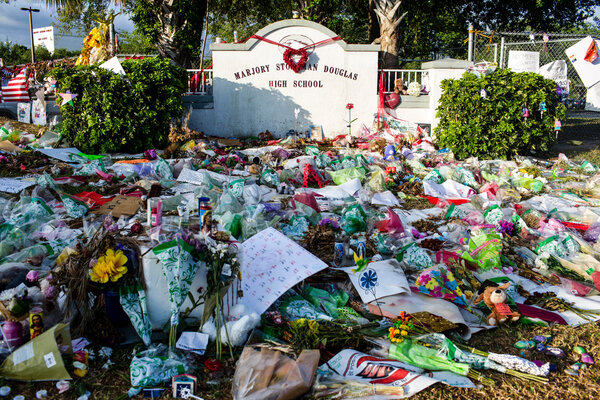FORT LAUDERDALE, Fla. — After unleashing six minutes of horror in the hallways of his former high school, where he fatally shot 17 people and injured 17 others, Nikolas Cruz fled to a Subway down the street and bought himself an Icee.
It was the afternoon of Feb. 14, 2018. Moments earlier, Mr. Cruz, then 19, had terrorized his ex-classmates in the freshman building of Marjory Stoneman Douglas High School, going back to shoot some of his victims again to make sure they were dead.
A Florida prosecutor recounted those and other wrenching details on Monday during the government’s opening statement in the sentencing trial of Mr. Cruz, now 23, who has pleaded guilty to 17 murders and 17 attempted murders. He now faces the death penalty or life in prison without the possibility of parole.
The painful events from that terrible day four years ago brought many victims’ parents to tears in the somber Fort Lauderdale courtroom, where prosecutors presented harrowing recordings from inside classrooms besieged by gunfire. A video with the sounds of gunshots and children screaming was so torturous that, at one point, the mother and father of one of the victims sitting in court yelled, “Shut it off!”
What happened in Parkland has long been investigated and known, and the defendant’s guilt was never in question. Yet the experiences of those who survived the attack felt urgent and shocking anew, in no small part because fresh outrage from another spate of mass shootings — including one in May that left 19 children and two teachers dead at an elementary school in Uvalde, Texas — has shaken the nation again.
“I’m going to speak to you about the unspeakable, about this defendant’s goal-directed, planned, systematic murder — mass murder — of 14 children, an athletic director, a teacher and a coach,” Michael J. Satz, the lead prosecutor, said, giving jurors a timeline of the events and reciting, victim by victim, where and how many times they were shot. Some of the jurors, who were listening intently in the jury box, flinched. The jury is made up of seven men and five women, plus 10 alternates.
The prosecutor described how the defendant, after a deadly rampage in which he fired 139 times from a semiautomatic rifle, slipped out of the school with other fleeing students. He ordered the Icee at Subway, sipped it on a bench inside Walmart and then walked into a nearby McDonald’s. There, he unsuccessfully asked a student who had run out of the school — and whose sister the defendant had just shot and injured — for a ride. He was arrested a short time later, while he was on foot about a mile away from the fast-food restaurant.
In court, Mr. Cruz wore glasses, a face mask and a sweater over a collared shirt. He showed little visible reaction during the prosecution’s opening, sitting largely hunched over as he appeared to be taking extensive notes and fiddling with a small notepad.
Defense lawyers chose not to give their opening statement until the prosecution finishes presenting its evidence, which could take up several weeks of a monthslong trial. Eventually, they intend to show that Mr. Cruz struggled with a difficult upbringing and mental health problems. They have requested permission to show jurors a map of his brain, but the judge has yet to decide whether to allow it.
Rarely does the gunman in a mass shooting face trial — and rarely do victims’ families sit through disturbing testimony and evidence from the attack. But on Monday, the first prosecution witnesses described in painful detail what happened that day.
Brittany Sinitch, a former Stoneman Douglas student who returned to her alma mater after college to teach, said her students were writing Valentine’s Day cards to one another as “Romeo and Juliet” characters when the loudest sounds imaginable — something she could feel in her chest — echoed from the hallway.
The students went straight into the active-shooter protocol they had been taught: They turned off the lights, closed the door and hid in the corners. Ms. Sinitch huddled under her desk with a few students while the shots continued.
“It just wouldn’t stop. I don’t have an absolute correct or accurate number that I could count,” she said. “It just kept going and going and going.”
In another classroom, Danielle Gilbert, who was a junior in Advanced Placement psychology, recorded cellphone videos from behind her teacher’s desk. She testified on Monday that she and other students were like “sitting ducks” as the defendant fired into the room, killing one person and wounding three others.
The videos, which were shown to jurors, showed students crouching and whispering in fear as bang after bang rang out. “This can’t be real,” one student whispered. One frame showed another cellphone screen, of someone on a call with “Mom.” Several jurors covered their mouths with their hands as they watched.
Eventually, police officers arrived. Students who had been kneeling started screaming and wailing at the sight of one of their classmates dead in a pool of blood. More bodies are seen in the hallway as Ms. Gilbert runs out of the building, escorted by armed law enforcement.
Though Judge Elizabeth A. Scherer barred the video images from being shown to the public when court was in session, the audio could be heard in the courtroom, eliciting sobs from relatives of the victims and prompting at least one woman to leave the room in tears. The defendant buried his head in his hands at the defense table.
Reporters were allowed to view the videos behind closed doors after the court session concluded. One aspect of the Parkland shooting that made it unlike earlier attacks was how students, who were teenagers with cellphones, recorded some of the events and posted them on social media, giving the public a glimpse of the horror they experienced.
Killed in the shooting were Alyssa Alhadeff, 14; Scott Beigel, 35; Martin Duque, 14; Nicholas Dworet, 17; Aaron Feis, 37; Jaime Guttenberg, 14; Christopher Hixon, 49; Luke Hoyer, 15; Cara Loughran, 14; Gina Montalto, 14; Joaquin Oliver, 17; Alaina Petty, 14; Meadow Pollack, 18; Helena Ramsay, 17; Alex Schachter, 14; Carmen Schentrup, 16; and Peter Wang, 15.
Jurors also watched a video from another classroom, played at a very loud volume, following the testimony of Dylan H. Kraemer, who was a junior at the time. “I looked over, and two people were dead and multiple people were shot,” he said. So many people were hurt that he could not recall all of their names.
The video startled the courtroom audience and prompted the parents of one of the students who died in that classroom to yell for the recording to be turned off. Defense lawyers asked for a mistrial as a result of the showing of the video and of the reaction of the deceased student’s parents. The judge denied the request.
Outside the courtroom, therapy dogs helped families and other spectators cope during recesses.
Mr. Satz said he planned to prove seven aggravating factors out of the 16 outlined in Florida law to justify the death penalty. Aggravating factors include that the defendant knowingly created a great risk of death to many people, that the murders were especially heinous, atrocious or cruel and that they were committed in a cold, calculated and premeditated manner.
Those factors “far outweigh any mitigating circumstances” in the case, Mr. Satz argued, including any details about the defendant’s mental health, childhood, schooling or therapy.
He told jurors he would show them surveillance video from inside the building that captured much of the shooting, though he warned that the rifle’s blast was so powerful it caused dust to fall from the ceiling at some points, halting the recording from motion-activated cameras.
“But most of it is there, and you will see it,” he said.
Near the beginning and end of his opening, which lasted just under an hour, Mr. Satz repeated the defendant’s own words from a cellphone video he recorded three days before the attack.
“I’m going to be the next school shooter of 2018,” the defendant said.



